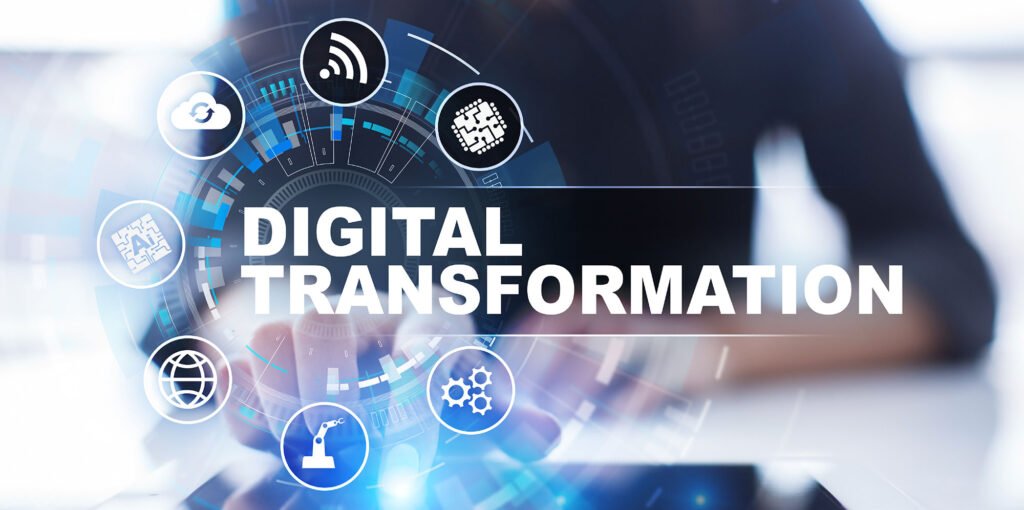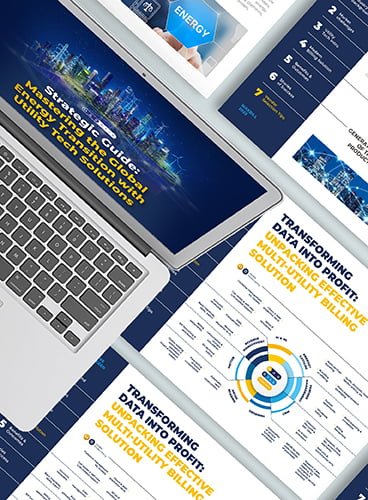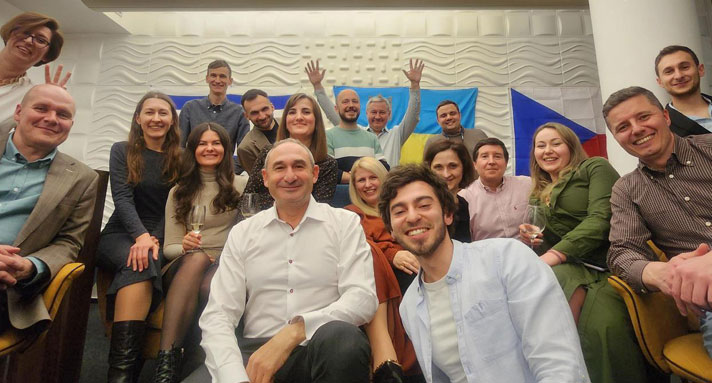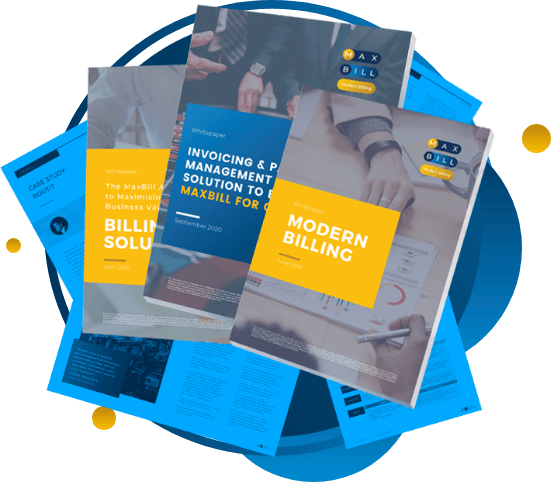Updated: Feb 2, 2025
Digital transformation in the energy industry and utility is an ongoing process, as the E&U market is always changing. You are reading this piece as a part of the sequence of articles under the Whitepaper “Strategic Guide: Mastering the Global Energy Transition with Utility Tech Solutions.”
A little introduction.
The journey to digital transformation in the energy and utility industry is crucial for businesses seeking to stay ahead during the energy transition. After delving into the essentials of digitalization and the future of energy in Part I (Mastering the Global Energy Transition) and exploring cutting-edge utility tech solutions in Part II ( Utility Tech Solutions to Outperform Under the Energy Transition), we now turn to Part III. Here, we present compelling real-life business cases, illustrating diverse needs and starting points, yet converging on one common goal: the successful evolution of business.
Part III is more than just a guide; it’s a treasure trove of expert insights and actionable advice, underpinned by real-world examples. It demonstrates that systems’ revamping is not just feasible but a strategic imperative. Here, you’ll learn to identify key metrics and functionalities vital for your business’s growth and how to select a technological solution that aligns with your unique needs. Join us as we demystify digital transformation in energy and utility, proving it’s not a ‘mission impossible’ but a journey towards innovation and excellence.
Now, let’s get to Part III, where you will discover:
- The basics of utility and power industry digital transformation
- Successful business through the lenses of problems, transformation strategy, and business outcomes
- Go-to tips and recommendations for selecting a solution provider for your transformation journey.
- The roadmap to transformations in 2024: three key things for utility tech leaders to focus on.
If you are ready to learn about the digital transformation in the energy industry through the great examples of different organisations and then understand how to achieve yours, let’s get started.

PART III
Digital Transformation in Energy Industry Explained by MaxBill

In the realm of energy and utility, it’s upgrading and optimising the capabilities that allow companies to perform better, better serve customers, and, at the end of the day, generate more revenue. Or it’s a complete overhaul of serving the market with innovative products, services, or business models.
Such a transformation is always aligned with the strategic goals of the company. Energy and utility organisations embarking on digital transformation need a well-defined vision and strategic execution plans, regardless of the scale of their overhaul.
For some companies, it’s even gaining “dragon-class capabilities.”
Gartner introduced the term “digital dragons,” meaning giant companies using their “technology prowess and power” to enter new markets, create a great customer experience, and even gain some dominance.
In our case, a new market is energy and utility. So, the question is how small and medium-sized utilities could compete with that. This is how the concept of ‘gaining dragon class capabilities” was born. You do not become a digital behemoth, but you gain the capability to do your best on the market. So, this is kind of enhancing existing processes and customer experiences.
Get to know the utility and power industry digital transformation business cases for both — upgrading and full overhaul.
At MaxBill, we had a client who needed to streamline and automate change-of-tenancy processes. Their current CRM system’s limitations made things difficult for them. After undergoing process automation, the one CoT process now takes 15 minutes. It is much faster than it used to be due to the cumbersome work between the different departments involved. We also improved the debt management flow.
First Utility (now Shell) embraced a digital overhaul to stay ahead in the competitive market and maintain its high standard of service delivery. A pivotal aspect of this transformation centered on billing and customer support, where adopting a holistic digital strategy was crucial. Shell broadened its services and transitioned away from outdated systems that hindered operational effectiveness.
This transformation effort is aimed at bolstering essential business functions like customer support and billing. It did so by incorporating integrated solutions for customer relationship management (CRM), order handling, management of meters and readings, pricing, product catalogues, and billing. Additionally, the introduction of a versatile workflow engine enabled the seamless integration and customisation of automated procedures throughout the company.
Based on the previous discussion, it’s clear that the digital transformation strategies in the utility sector fall into two primary categories:
- Digital Optimization: This involves refining current operations and improving the customer experience.
- Full-scale Digital Transformation of Energy Management: This signifies a fundamental shift in how the market is served, introducing new products, services, or business models.
Digital Transformation in the Energy Sector is “Multi-Faced”

Nowadays, the era of renewables, making the digital transformation in renewable energy on-point. By 2027, green power will surge by 2,400 GW, matching China’s entire capacity and dominating 90% of global electricity growth. This means utilities should be ready to stay competitive, reliable, and resilient. In this case, utilities are advised to digitise the following:
- Digitise grids to adopt variable energy sources
- Shift towards digital load management and digital transformation in energy management
- Implement a digital twin of the network to accurately plan energy production and consumption.
- Digitise to enhance network efficiency and reliability
Another side of digital transformation is internal processes, especially those related to customer experience. Why? Because customer satisfaction in energy and utility is king and managing customers and their billing is simply crucial.
According to a recent report by Utility Week and the international digital payments company PayPal, the trend in the utility industry, particularly within the UK, has been notably downward in terms of customer satisfaction.
The latest findings from the UK Customer Satisfaction Index (UKCSI) for July 2023 underscore this trend, positioning utilities as the lowest-performing sector.
According to Jo Causon, the chief executive of the Institute of Customer Service (ICS), utility leaders should focus on the digital experience to improve customer satisfaction.
Interestingly, this very report names the number one block to improve the digital experience, which is a legacy technology stack when integrating new solutions. This is the subject of digital transformation.
Therefore, improving customer satisfaction is possible through improving the digital experience, which is impossible without updating or transforming the legacy technology stack.

Digital Transformation in the Energy Industry via Brilliant Business Cases in E&U
The digital transformation of the energy industry requires a clear vision and deliberate execution strategies, however extensive your revamping will be. The following real-world examples manifest a clear vision and defined strategy that the companies accepted thanks to securing the help of a third-party expert company with whom they embarked on the transformational journey.
These cases underscore:
- Critical phases and key milestones in the transformation process.
- Essential resources that streamlined the journey, ensuring timely and successful implementation.
- Strategies for planning and achieving successful digital integration.
Digitalization in the energy sector is not a one-size-fits-all strategy. Leadership teams must tailor their digital goals to shape their strategy, specifying the nature and scope of the desired business impacts. This tailored approach guides investment decisions and the sequencing of digital initiatives.
The benefits of digitalization in the energy sector can be categorised into two main types:
- Digital Optimisation: Enhancements to existing processes and customer experiences.
- Digital Transformation: A complete overhaul in serving the market with innovative products, services, or business models.
Continue exploring these case studies to gain valuable insights and inspiration for crafting your own success story in the realm of energy and utilities digital transformation.
E.On’s Success: Digital Transformation with the Largest and Fastest Customer Migration in the UK
E.ON UK, a key player in E.ON Next Energy Limited—one of Europe’s premier energy conglomerates—has successfully navigated a major transformation, evolving from a longstanding energy supplier to a dynamic, agile enterprise start-up. In the process, the company has managed to maintain its strong commitment to sustainability, while also implementing an innovative operating and technology model, with a cutting-edge customer-to-cash cloud platform at its core.
Challenges and Problem Statement

- Strategic Brand Consolidation: In response to the global pandemic, E.ON UK decided to unify its customer base under a new brand, E.ON Next, necessitating a smooth transition for customers from both E.ON and various other power supplier brands.
- Risk of Disruption: The migration process was complex and posed significant risks, with the primary challenge being the transfer of customers across different brands and service platforms without disrupting their experience or the company’s regular business operations.
- Potential for Customer Attrition: Any errors or mismanagement during the migration could lead to customer dissatisfaction, increasing the likelihood of customers switching to competitors, resulting in potential losses for E.ON UK.
- Historical Precedents: There were precedents within the UK energy industry of companies facing difficulties during similar migration efforts from outdated legacy systems, which had led to customer loss, reduced revenue, and reputational damage, highlighting the risks and stakes involved for E.ON UK.
The Business Transformation Strategy
To navigate these challenges, E.ON UK established three primary work streams as part of its digitalization strategy:
- New Operating Model: The implementation of a new operating model wherein specialised teams would manage all interactions with a defined group of customers, ensuring consistency and efficiency in customer service.
- Customer Migration: A meticulous approach to customer migration, aimed at maintaining consistency across all channels and platforms, thereby ensuring a seamless transition for customers.
- Legacy System Overhaul: The phasing out of outdated legacy systems, replaced by an end-state architecture designed to be more efficient and effective.
Outcomes and Global Results

- Enhanced E.ON Next Customer Service: Such a significant transition strategy has significantly improved customer service operations at E.ON UK.
- Leaner Organisation: Adoption of the new operating model and technology platform has resulted in a more streamlined and efficient organisation.
- Faster Decision-Making: The company now benefits from quicker and more responsive decision-making processes, which are closely aligned with customer interactions.
- Scalability and Flexibility: The platform and operating model are both scalable and flexible, allowing E.ON UK to swiftly adapt to regulatory changes and evolving customer needs.
- Industry Leadership: These improvements ensure that E.ON UK continues to lead in the energy industry, even in the face of ongoing challenges and changes in the market.
Eneco’s Journey: Expanding into New Growth Sectors
Eneco Group, a leading figure in the energy sector, has strategically embarked on a journey of operational optimisation, ensuring that efficiency remains paramount. Through a comprehensive restructuring and simplification of its organisational structure, Eneco Group has embraced digital tools and digital technologies to streamline its processes. A subsidiary of Eneco Energy, Joulz, plays a pivotal role in this transformation, providing a range of services from design and engineering to maintenance and emergency support for gas and electricity distribution grids, serving two million residences in the Netherlands.
Challenges and Problem Statement
- Operational Issues: Joulz aimed to achieve the highest standard in operational performance.
- Minimising Client Connection Disruptions: A key goal was to reduce interruptions to client connections during the optimisation process.
- Optimising Distribution Grid Operations: There was a critical need to enhance the efficiency and effectiveness of grid operations.
- Cost-Efficiency: The company strived to maintain and construct grids and connections at the most optimal costs.
- Maintaining Efficiency and Reliability: It was imperative to uphold high standards of efficiency and reliability, even while making operational changes.
- Changing Operational Procedures: Achieving these goals necessitated a significant shift in how operational procedures were carried out.
- Reimagining the Organisational Framework: The existing organisational structure and processes needed to be reconsidered and restructured to meet the new operational objectives.
The Business Transformation Strategy

Joulz embarked on a digital transformation journey, underpinned by two strategic moves:
- ERP System Integration: Automating operational procedures to enhance efficiency and reduce manual errors.
- Deployment of a Business Support Management System: Driving and monitoring process excellence, ensuring that all operations, from order to payment, were seamlessly processed.
This comprehensive digital solution aligned automated operations with Joulz’s administrative and field operating tasks, ensuring smooth coordination and efficiency across the board. The digital transformation required meticulous planning and constant monitoring to ensure seamless integration and performance of the new systems.
Outcomes and Global Results
- Operational Efficiency: Digitalization of energy has significantly enhanced operational efficiency at Joulz and Eneco Group.
- Reduction in Client Connection Disruptions: There has been a noticeable decrease in disruptions to client connections.
- Strategic Market Positioning: Eneco has strategically positioned itself in new growth markets, capitalising on its strong brand and substantial client base.
- Introduction to Smart-Energy Solutions: The rollout of smart-energy solutions has contributed to an increase in revenues and a decrease in customer attrition rates.
- Financial Savings: The company has achieved a structural reduction in software and maintenance costs, totalling 75,000 euros annually and a cumulative savings of 15 million euros.
- Enhanced Customer Experience: Customers now have access to valuable insights regarding their energy usage, boiler performance, and energy-saving tips, all available through a monthly membership, enhancing their overall experience.
- Strengthened Industry Position: These outcomes have served to reinforce Eneco’s standing as a leader within the energy sector.
Shell’s Digital Transformation in Utilities: From 50K to 2M Service Points
Shell Energy Retail (former First Utility), a leader in providing 100% renewable electricity, gas, broadband, and smart home technology, is committed to delivering simplicity, reliability, and affordability to households across the UK. The company stands out for its innovative technology solutions aimed at enhancing customer service and ensuring operational efficiency.
Challenges and Problem Statement

- Outdated Legacy Systems: The company’s operations were hindered by legacy systems, which were not capable of supporting the desired level of efficiency and operational agility.
- Operational Inefficiencies: These legacy systems led to significant operational delays, affecting the overall customer experience.
- Adoption of New Service Packages: The introduction of new and improved service packages was a strategic priority, but the transition was impeded by the outdated systems in place.
- Need for Digital Transformation: To remain competitive and continue delivering exceptional services, a comprehensive digital transformation strategy, particularly in billing and customer service, was essential.
Strategy and Implementation
- Smart Meter Implementation: Shell transitioned from a traditional consumer-supplier relationship to innovative smart meters, empowering customers to manage and regulate their own energy consumption.
- Expansion of Service Packages: Shell expanded its service offerings and moved away from the legacy systems that were previously a bottleneck to operational efficiency.
- Implementation of Integrated Solutions: The business initiatives included enhancing core business capabilities such as customer service and billing through pre-integrated CRM, order management, meter and readings management, rating, product catalogue, and invoicing modules.
- Flexible Workflow Engine: A new flexible workflow engine was implemented, facilitating easy integration and configuration of automated processes across the organisation.
Outcomes and Global Results

- Enhanced Operational Efficiency: The digital transformation led to the elimination of previous operational inefficiencies.
- Improved Customer Service: Implementation of a comprehensive CRM and highly automated processes, including bots at the helpdesk, resulted in a significantly enhanced customer service experience.
- Efficient Data Management: The company achieved more streamlined and efficient management of customer data.
- Advanced Billing Solution: The adoption of a powerful billing solution enabled the flexibility to accommodate virtually any payment scheme, aligning with customer needs and preferences.
- Service Innovation: Shell Energy Retail successfully introduced new service packages, further enriching its offering to customers.
This next chapter zeroes in on the critical process of choosing the ideal utility billing solution provider and utility tech in general, setting the stage for a successful and transformative digital journey.
Choosing the Right Tech Vendor for Digital Transformation in Utilities and Energy Industry
At MaxBill, we are not just utility billing providers and don’t just offer solutions; we partner for success. Our approach is rooted in 27 years of experience, where our experts don’t just collaborate with tech leaders in energy and utilities but continually refine their knowledge through market analysis and self-education.
This unique blend of experience and expertise has enabled us to devise four fundamental tips for selecting the right solution provider, tailored for organisations aiming to either update legacy systems or fully embrace digitalization in the energy sector.
Key points to consider before hitting the road:

- Complex Production Environments: CIS handle vast amounts of data within intricate production settings.
- Time-Intensive Implementation: Implementing a CIS system typically takes two years or more.
- Well-Defined M2C Capabilities: Back-office Meter-to-Cash capabilities are generally standardized; herewith, a utility billing services provider can tailor them to specific needs.
- New Requirements from Market Transitions: Evolving customer expectations and energy market changes introduce new requirements.
- Potential Shortcomings of Single-Vendor Solutions: A monolithic, single-vendor CIS solution may not adequately address all emerging needs.
- Market Maturity and Baseline Functionalities: Most vendors in the matured market offer products with a readily available set of baseline functionalities.
- Need for Configuration and Integration: Despite available functionalities, efficient implementation requires careful configuration and system integration.
- Addressing Specific Operational Needs: Implementation efforts should fulfil specific operating requirements, rate structures, regulatory specifications, and market interfaces, which may vary by jurisdiction.
Further tips will significantly help in choosing the right solution provider among the thousands on the market.
TIP 1: MAKE A PRIMARY EVALUATION OF:

- Resource Availability: Assess the availability of skilled resources for implementation, ensuring there are adequate personnel with the necessary expertise.
- Specialized IT Service Providers: Look for IT service providers that specialize in your industry, bringing extensive product expertise and experience.
- Proactive Risk Management: Encourage IT leaders to think ahead about potential implementation challenges and to proactively manage project risks.
- Vendor’s Solution Modularity: Evaluate whether the vendor offers a modular CIS solution, composed of pre-packaged business capabilities.
- Expandability of Product: Ensure the potential technology provider’s product can be expanded, either with third-party features or custom-built business capabilities.
- Collaborative Capability Definition: Promote collaboration among business leaders to precisely define the specific capabilities required to achieve desired business outcomes.
- API Documentation for Integration: Work closely with the chosen product vendor to ensure that the CIS solution provides well-documented APIs for all exposed capabilities, facilitating seamless integration and future scalability.
- Scalability and Interoperability: Verify that the CIS solution is not only fit for current needs but also designed for future scalability and interoperability, allowing for adaptability to evolving business models and market demands.
TIP 2: DEFINE COMPANY-SPECIFIC, BUSINESS OUTCOME-DRIVEN METRICS BEFORE EVALUATING TECHNOLOGY VENDORS

- Prioritise Value-Quantifying Metrics: Focus on metrics that clearly quantify the technology’s value in terms of revenue generation, cost savings, and risk mitigation across the utility value chain.
- Consider Gartner’s recommendation to categorise metrics into three types:
- aggregated business outcomes: metrics related to profitability or financial performance
- business-outcome-driven metrics: the ones measuring customer service provisioning costs and asset reliability
- technology-outcome-driven metrics: the percentage of AMI metre reads, percentage of digitally completed customer service requests, and percentage of digitally connected assets. etc.
- Align Metrics with Transformation Strategy: Ensure that the identified metrics are in line with the company’s transformation strategy to drive coherent and strategic development.
- Communicate Business Outcomes to Executives: Effectively articulate the identified business outcomes and their benefits to executive leaders to garner the necessary support and alignment.
- Integrate Metrics into Vendor Evaluation: Embed these defined metrics into the evaluation process of technology vendors to ensure alignment with business objectives and desired outcomes.
TIP 3: EVALUATE THE POTENTIAL THROUGH THESE 10 LENSES

- Industry Knowledge and Expertise: Look for a utility billing services provider with a deep understanding of utility markets, regulatory requirements, customer expectations, and how these factors impact system functionality.
- Demonstrated Operational Efficiency and Business Agility: Ask for examples and case studies showcasing how the vendor’s technology has improved operational efficiency and enabled increased agility for utility companies.
- Partnerships and Collaborations: Inquire about the vendor’s partnerships with system integrators and other relevant industry stakeholders, as this can enhance their ability to deliver comprehensive solutions.
- Value Proposition of Digital Technology: Seek a clear and compelling explanation of how the vendor’s digital technology solution delivers value to utility companies, including improved processes, cost savings, and enhanced customer experiences.
- Implementation Roadmap: Request an initial roadmap outlining the implementation process, including key milestones, timelines, and resource requirements. This will help you understand the steps involved and align expectations.
- Strategic Business Support: Assess the vendor’s commitment to supporting your strategic business imperatives and goals. This may include ongoing support, consultation, and guidance throughout the partnership.
- Industry-Specific Approach: Understand how the vendor approaches industry-specific challenges and tailors their solutions to address the unique needs and complexities of the utility sector.
- Client Testimonials and Use Cases: Ask for client testimonials and use cases to gain insight into the vendor’s track record, client satisfaction, and successful implementations in the utility industry.
- Open Communication with IT Staff: Ensure that the vendor fosters open and transparent communication with your IT staff, facilitating collaboration and knowledge sharing.
- Valuable Insights for Executive Leaders and Stakeholders: Evaluate whether the vendor can provide valuable insights and reporting that will be useful for executive leaders and stakeholders in making informed decisions and driving business growth.
TIP 4: DEFINE WHAT FUNCTIONALITY SHOULD QUALIFY YOUR UTILITY PRODUCT

Below, we’re presenting an example of a ‘functionality review’ if one is searching for a revenue management solution.
On the journey of researching and selecting the revenue management solution, it’s crucial to define the specific functionalities that qualify the product for your business needs and growth strategy.
- Pricing Management: The product should have the capability to track and manage individual or group product and service pricing, allowing for flexibility and customization.
- Revenue Recognition and Allocations: Look for features that facilitate accurate revenue recognition and allocations, ensuring that revenue is properly attributed and accounted for.
- Performance Evaluation: The solution should enable the evaluation of package performance, special offers, and incentives, providing insights into their impact on revenue generation.
- Handling Different Revenue Types: Ensure that the product can handle different types of revenue models, such as transaction-based revenue and recurring revenue, supporting the diverse needs of your business.
- Discount and Rebate Analysis: The solution should be able to assess the effects of discounts and rebates on overall revenue, allowing for better analysis and decision-making.
- Revenue Tracking: Look for functionality that enables revenue tracking on a contract, customer, or project basis, providing granular visibility into revenue streams and performance.
- Best Practices and Optimization: Seek a product that incorporates industry best practices for revenue management, ensuring that your processes are optimised and aligned with industry standards.
Digital Transformation in the Energy Sector: 3 Core Paths to Focus on in 2024
The market today demands agility. With a staggering 94% of energy service providers acknowledging the struggle to move quickly, it’s clear that the industry needs a strategic pivot. The goal isn’t to increase the number of products but to enhance operational efficiency and customer value. Here are a few tips to follow.
Strategic Advice: Less is More
2024 should be a year of reflection and simplification. The focus should shift from churning out numerous products to honing in on what truly matters. The key lies in understanding and optimising for customer lifetime value (CLTV), rather than just reducing costs. This approach enhances the customer experience and drives long-term business value.
Path to Solutions: Simplify, Optimize, Innovate
Take Stock: Audit your internal systems and understand how different components connect. Simplify your digital infrastructure by eliminating redundant components and streamlining processes.
Focus on CLTV: Align your business strategy to increase customer lifetime value. This involves identifying high-value opportunities and optimising product offerings.
Leverage Technology: Embrace automation and AI for billing and customer care operations. Simplify your data architecture to maximise AI capabilities, leading to cost reduction and enhanced efficiency.
Key Takeaways for Companies’ Leaders
- Choose a modular solution: To address the energy transition, opt for a utility billing and CRM System that is modular and can be expanded with third-party features or custom-built capabilities to meet evolving requirements.
- Focus on quantifiable value metrics: When selecting a technology vendor, prioritise metrics that demonstrate quantifiable value in terms of revenue, cost savings, and risk mitigation across the utility value chain.
- Assess industry knowledge and expertise: Look for a vendor with deep understanding of utility markets, regulatory requirements, and customer expectations, as well as a track record of improving operational efficiency and business agility.
- Consider partnerships and collaborations: Check if the vendor has established partnerships with system integrators or other industry players, indicating their commitment to providing comprehensive solutions.
- Seek open communication and support: Ensure the vendor offers open communication channels with your IT staff and provides support to help achieve your strategic business goals.
- Define functionality requirements: Clearly define the specific functionality you need, such as pricing management, revenue recognition, performance evaluation, and optimisation based on industry best practices.
- Consider testimonials and use cases: Request testimonials and use cases from existing clients to gauge the vendor’s track record and client satisfaction.
By considering these factors and aligning with business leaders, you can make informed decisions when selecting a technology vendor for your CIS implementation, ensuring a successful and efficient transition to a modern and adaptable solution that meets your utility company’s specific needs.
Interested in embarking on the digital transformation journey with MaxBill? Connect with our experts!

































